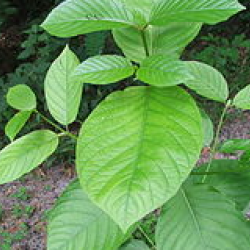The top exporter, Indonesia, is so worried about its impact they don't allow it in their own borders, it can only be grown to be sold in other countries.
Supplement buyers swear by it, touting its benefits for chronic or acute pain as well as mood conditions such as depression and anxiety. They even insist it will help with opioid withdrawal, though that is an odd claim since 2 of the top 5 compounds in kratom activate opioid receptors, making them actual opioid agonists, while 22 of the 25 compounds in kratom bind to mu-opioid receptors.

Being classified as an herbal supplement does not make something safe, but thankfully only 11 deaths have followed kratom use so far. Still, health experts are concerned. A new study conducted by the Center for Injury Research and Policy and the Central Ohio Poison Center at Nationwide Children's Hospital found that there were more than 1,800 calls to U.S. Poison Control Centers regarding exposures to kratom from January 2011 through December 2017.
7 newborns with kratom side effects and 69% of kratom exposures in pre-teens were actually toddlers
Among the 48 kratom exposures that involved children age 12 years and younger, 69% were children younger than two years, including seven newborns, five of whom were experiencing withdrawal.
The overall increase is also worrisome. There were only 13 calls in 2011 but that shot up to 682 in 2017. Almost two-thirds (65%) of the exposures occurred from 2016 through 2017- the two most recent years of the study.
As you might expect, most exposures occurred among males (71%), at a residence (86%), and were intentional abuse or misuse (60%), suspected suicide (9%), or adverse reaction (8%). Exposure rates were highest in Idaho and Oregon and were lowest in Delaware and Wisconsin.
Overall, nearly one third (32%) of the calls resulted in admission to a healthcare facility and more than half (52%) resulted in serious medical outcomes, especially among teenagers and adults. Taking kratom with another substance increased the odds of admission to a health care facility (odds ratio - OR - 2.80) and of having a serious medical outcome (OR 2.25). The medical effects ranged from tachycardia (rapid heartbeat), agitation/irritability, and hypertension (high blood pressure) to seizures, coma (loss of consciousness), increased bilirubin, renal (kidney) failure, and death.
Data for this study were obtained from the National Poison Data System, which is maintained by the American Association of Poison Control Centers (AAPCC). The AAPCC receives data about calls to poison control centers that serve the U.S. and its territories. Poison control centers receive phone calls through the Poison Help Line and document information about the product, route of exposure, individual exposed, exposure scenario, and other data.




Comments